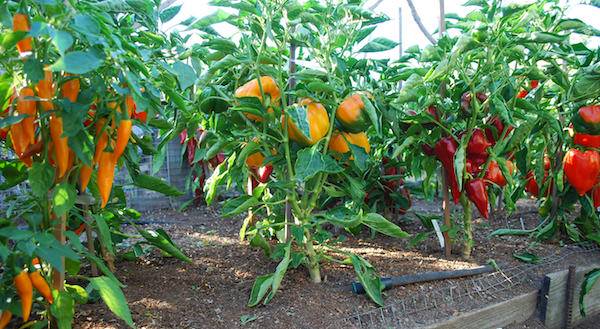Peppers are a warm weather crop that can yield abundantly when grown in a raised bed. The elevated planting mix warms faster while providing excellent drainage. With proper spacing, consistent moisture, and balanced fertility, you’ll harvest basketfuls of colorful bell peppers, spicy chiles, and more. Follow this guide to plant peppers in a raised bed for your most productive crop ever.
Choose a Sunny Spot
Peppers need at least 6-8 hours of direct sun daily, with more light yielding higher productivity. Select the sunniest part of your yard when siting your raised bed Avoid shade from buildings, fences or trees that may limit light exposure Morning sun is particularly important to dry dew from the leaves and prevent disease. A south-facing location is ideal.
Prepare the Soil
Peppers want loose fertile soil that drains readily. Adding organic matter like compost or well-rotted manure to your raised bed before planting is recommended. You can also mix in worm castings, leaf mold and aged animal manures.
Small amounts of bone meal or rock phosphate will provide a phosphorus boost to aid flowering and fruiting. Mix amendments into the top 6 inches of soil before planting.
Know Your Last Frost Date
Pepper seeds can be sown directly in beds 2-3 weeks after your final frost. But transplants give you a sizable head start on the season.
Start seeds indoors 6-8 weeks before your average last spring frost to get transplants ready for planting out. Harden off the seedlings for 7-10 days before transplanting them into the raised bed after all risk of frost has passed.
Allow Proper Spacing
Most peppers need 18-24 inches of space in all directions. Some compact types like shishitos can thrive at 12 inch spacing. Wider spacing prevents crowding issues.
Mark spots for transplanting seedlings about 2 feet apart. You can fill in with quicker growing crops like lettuce or herbs around the pepper plants. Just keep 18 inches of space around each plant once they are full grown.
Dig Wide Planting Holes
Use a trowel to dig a hole that’s just as deep but twice as wide as the transplant’s nursery pot. Creating a wide hole allows you to spread the roots outward, promoting quick establishment.
Gently loosen any circling roots before placing the seedling in the hole. Backfill with your enriched soil blend, covering up to the same soil level on the stem where it was growing in the pot.
Water Thoroughly
Water newly planted seedlings daily for the first week, then begin tapering off to twice weekly watering. Soak the entire root zone deeply when watering established plants. Avoid frequent shallow watering, which leads to roots staying near the surface.
Consistent moisture is key, but take care not to overwater. Let the soil surface dry out before soaking again. Use drip irrigation or soaker hoses to target water to the base of plants.
Apply Mulch
Spread 2-3 inches of shredded leaves, straw or other organic mulch around plants after transplanting. Keep mulch a few inches away from stems to prevent disease. The mulch will help retain soil moisture and regulate temperatures.
As the season progresses, you can add more mulch around the base of pepper plants to continue suppressing weeds. Replenish any thinning mulch with fresh material.
Install Support
Staking peppers keeps top-heavy fruit loads from causing snapped branches. Use tall stakes and loosely tie main stems to provide support without constricting the plant.
Tomato cages or small-holed fencing also work well for surrounding and holding up sprawling pepper plants. Add supports shortly after transplanting or when plants are still small.
Side Dress with Fertilizer
Around the time the first pepper flowers appear, side dress plants with organic fertilizer to fuel fruiting. Use 1-2 tablespoons per plant, keeping it 6 inches away from stems. Sprinkle slow-release organic granular fertilizer or diluted fish emulsion around each plant.
Repeat fertilizing every 3-4 weeks through the active growing season. This will replace nutrients used up during heavy flowering and fruit production.
Monitor for Pests
Check under leaves for aphids or signs of disease. Catch problems early and treat organically at first sight. Common pepper pests include aphids, flea beetles, corn borers and tarnished plant bugs.
Good sanitation and proper spacing helps prevent diseases. Pick off diseased leaves immediately to avoid spreading infections.
Harvest Regularly
Begin harvesting peppers once they reach mature size and ideal color for the variety. Pick often to spur further production. Use pruners or scissors for clean cuts that won’t damage plants.
Letting fruits overly ripen before picking leads to fewer total peppers over the season. Frequent harvesting keeps plants continually producing new flowers and fruits.
With the right variety, soil, sunlight and care, your raised bed pepper patch will reward you with mountains of sweet bell peppers, spicy chiles and more all season long.
How to Plant 12 Peppers in a 2×6 ft. Raised Bed: Soil, Fertilizing, Moisture is Key, Spacing & More
FAQ
What to put in a hole when planting peppers?
How many peppers in a raised bed?
How close together do you plant pepper plants?
Can I plant tomatoes and peppers in same raised bed?
- A Complete Guide to Caring for Yuki Cherry Blossom Shrub - January 23, 2025
- Identifying Red Hot Poker Seeds: What to Look For When Harvesting Torch Lily Pods - January 23, 2025
- A Complete Guide to Harvesting Evening Primrose Seeds - January 23, 2025

